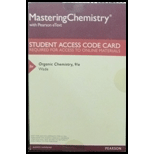
(a)
Interpretation:
The structures of poly (vinyl acetate) and poly (vinyl alcohol) are to be stated.
Concept introduction:
The poly (vinyl acetate) and poly (vinyl alcohol) are examples of addition
(b)
Interpretation:
An explanation to predict that the poly (vinyl acetate) is polyester as vinyl acetate is an ester is to be stated.
Concept introduction:
The poly (vinyl acetate) and poly (vinyl alcohol) are examples of addition polymers. These polymers are made, when some alkenes undergo chain growth polymerization by some initiator.
(c)
Interpretation:
An explanation corresponding to the given statement that hydrolysis does not destroy the poly (vinyl alcohol) polymer is to be stated.
Concept introduction:
The poly (vinyl acetate) and poly (vinyl alcohol) are examples of addition polymers. These polymers are made, when some alkenes undergo chain growth polymerization by some initiator.
(d)
Interpretation:
An explanation corresponding to the given statement that the poly (vinyl alcohol) is made by given circuitous route rather than the polymerisation of vinyl alcohol is to be stated.
Concept introduction:
The poly (vinyl acetate) and poly (vinyl alcohol) are examples of addition polymers. The poly (vinyl acetate) is converted to poly (vinyl alcohol) by a basic hydrolysis of the ester groups.
Want to see the full answer?
Check out a sample textbook solution
Chapter 26 Solutions
Masteringchemistry With Pearson Etext -- Valuepack Access Card -- For Organic Chemistry
- a. What molecular features make a polymer flexible? Explain how cross-linking affects the properties of polymer? b. In copolymers made of ethylene and PMMA, the melting point and degree of crystallinity decrease as the percentage of PMMA increases. Suggest an explanation for this observation.arrow_forwardPolyethylene terephthalate(PET) is a versatile polyester (shown below). Polomon of -CH₂-0- n What is the class of the polymer shown? What are the structures of the monomers? A. HO B. H3C. C. HO-C- D. HO OH OH -OH -OH → polymerarrow_forward3. Polymer structures i) Draw the chemical structure of the "mer", ii) compute repeat unit molecular weights (in g/mol) for the following and iii) identify one application for each of these polymers in biomedical engineering. a. poly(tetrafluorethylene) b. poly(lactic acid) c. Poly (ethylene terephthalate) d. Poly(dimethyl siloxane)arrow_forward
- They tend to strengthen a material (such as a plastic) made from this polymer. They also make the polymer harder and more difficult to melt. a. crosslinks b. Thermoplastics c. pendant groups d. backbonearrow_forwardTeflon is the polymer used to create non-stick surfaces on cookware. The monomer for Teflon is tetrafluoroethene. a. Draw tetrafluoroethene. b. What type of polymerization reaction would be used to create Teflon? c. Show the repeat unit of Teflon. d. Explain based on the molecular structure of Teflon why it would have the non-stick and chemically resistant properties that make it suitable for use in pots and pans.arrow_forward7. During condensation polymerization, many monomers join together. What is lost when two mon omers join together via a condensation reaction? carbon dioxide b. hydrochloric acid c. hydrogen gas а. d. waterarrow_forward
- Poly(vinyl alcohol), a hydrophilic polymer used in aqueous adhesives, is made by polymerizing vinyl acetate and then hydrolyzing the ester linkages. Give the structures of poly(vinyl acetate) and poly(vinyl alcohol)arrow_forwardThe following applications are associated with a particular polymer or plastic. Name the polymer, write the structure of the (a) repeating unit and (b) the monomer and name the monomer. h. Handles for flat irons and cookwares i. Artificial organs for surgical implantations j. Liners in astronauts helmetarrow_forward4. Recycle bottles of plastic are made from а. Реeptides b. Polyamides c. nylon d. polyethylene terephthalate 5. In condensation of polymerization, monomers are involved which contain functional groups of a. same kind b. different kind C. all groups d. compounds 6. Large molecules made up of small monomers are called a. Polymers b. Peptides c. peptones d. monomers d pumbers react together in additionarrow_forward
- Chemistry: Matter and ChangeChemistryISBN:9780078746376Author:Dinah Zike, Laurel Dingrando, Nicholas Hainen, Cheryl WistromPublisher:Glencoe/McGraw-Hill School Pub Co
 Introductory Chemistry: An Active Learning Approa...ChemistryISBN:9781305079250Author:Mark S. Cracolice, Ed PetersPublisher:Cengage Learning
Introductory Chemistry: An Active Learning Approa...ChemistryISBN:9781305079250Author:Mark S. Cracolice, Ed PetersPublisher:Cengage Learning Introductory Chemistry: A FoundationChemistryISBN:9781337399425Author:Steven S. Zumdahl, Donald J. DeCostePublisher:Cengage Learning
Introductory Chemistry: A FoundationChemistryISBN:9781337399425Author:Steven S. Zumdahl, Donald J. DeCostePublisher:Cengage Learning  EBK A SMALL SCALE APPROACH TO ORGANIC LChemistryISBN:9781305446021Author:LampmanPublisher:CENGAGE LEARNING - CONSIGNMENT
EBK A SMALL SCALE APPROACH TO ORGANIC LChemistryISBN:9781305446021Author:LampmanPublisher:CENGAGE LEARNING - CONSIGNMENT Chemistry: Principles and PracticeChemistryISBN:9780534420123Author:Daniel L. Reger, Scott R. Goode, David W. Ball, Edward MercerPublisher:Cengage Learning
Chemistry: Principles and PracticeChemistryISBN:9780534420123Author:Daniel L. Reger, Scott R. Goode, David W. Ball, Edward MercerPublisher:Cengage Learning Chemistry: The Molecular ScienceChemistryISBN:9781285199047Author:John W. Moore, Conrad L. StanitskiPublisher:Cengage Learning
Chemistry: The Molecular ScienceChemistryISBN:9781285199047Author:John W. Moore, Conrad L. StanitskiPublisher:Cengage Learning





